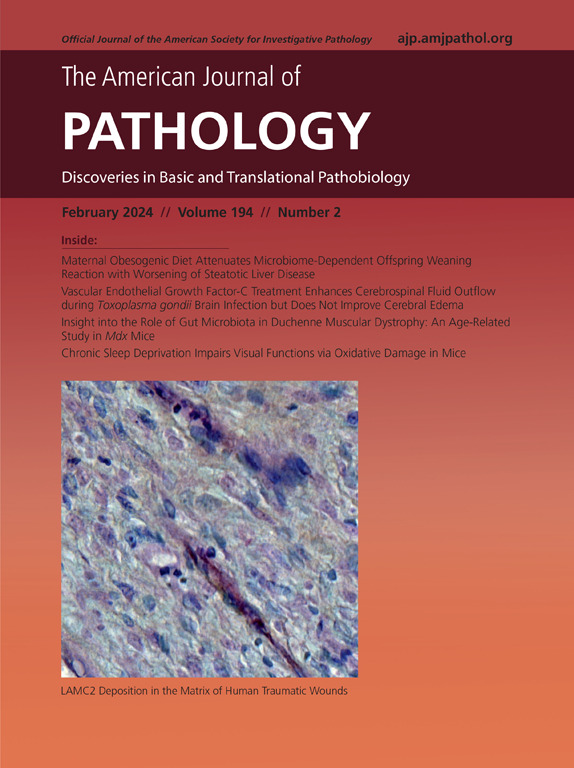Regulation of Adiponectin and Resistin in Liver Transplantation Protects Grafts from Extended-Criteria Donors
IF 4.7
2区 医学
Q1 PATHOLOGY
引用次数: 0
Abstract
The donor shortage increases liver transplantation (LT) waiting lists, making it crucial to consider extended-criteria donors, such as steatotic donors after brain death (DBDs) or cardiocirculatory death (DCDs). Nevertheless, steatosis, brain death, and cardiocirculatory death are key risk factors for poor LT outcomes. Herein, the role and therapeutic usefulness of several adipocytokines was investigated to protect such grafts from extended-criteria donors. Sprague rats with nutritionally induced steatosis were used in an experimental LT model with grafts from DBDs or DCDs. Adiponectin, resistin, and visfatin were measured and pharmacologically modulated, and effects on liver injury were assessed. Visfatin played no role under conditions of either DBD or DCD LT. Brain death increased adiponectin and reduced resistin. Adiponectin harmed steatotic and nonsteatotic DBD grafts, via a resistin-dependent mechanism; restraining adiponectin increased resistin, reducing damage. Resistin treatment protected both types of DBD grafts, whereas suppressing it increased damage. This adiponectin-resistin pathway was dependent on protein kinase C. In DCD LT, adiponectin and resistin were not modified in nonsteatotic grafts, but reduced in steatotic ones. Adiponectin or resistin treatments protected steatotic grafts: hepatic adiponectin activated AMP-activated protein kinase ; hepatic resistin increased phosphatidylinositol 3-kinase–Akt. Concomitant administration of both adipocytokines increased both signaling pathways, intensifying protection. These data suggest that pharmacologic modulation of adiponectin and resistin as therapies might potentially be translated to clinical studies to improve surgical outcomes for LT from extended-criteria donors.
调节肝移植中的脂肪连接蛋白和抵抗素可保护来自扩展标准捐献者的移植物。
供体短缺增加了肝移植(LT)等待名单,因此考虑延长标准供体(ECD)至关重要,例如脑死亡(DBD)或心循环死亡(DCD)后的脂肪变性供体。尽管如此,脂肪变性、脑死亡和心循环死亡仍是导致低温床不良预后的关键风险因素。我们研究了几种脂肪细胞因子在保护此类移植物免于 ECD 方面的作用和治疗用途。我们用营养诱导脂肪变性的 Sprague 大鼠与来自 DBD 或 DCD 的移植物组成实验性 LT 模型。对脂肪连素、抵抗素和粘蛋白进行了测量和药理调节,并评估了它们对肝损伤的影响。在 DBD 和 DCD LT 条件下,Visfatin 都不起作用。脑死亡增加了脂肪连接蛋白,减少了抵抗素。脂联素通过一种抵抗素依赖性机制损害脂肪变性和非脂肪变性的DBD移植物;抑制脂联素会增加抵抗素,从而减少损伤。抵抗素处理可保护这两种类型的 DBD 移植物,而抑制它则会增加损伤。这种脂联素-抵抗素途径依赖于 PKC。在 DCD LT 中,非脂肪性移植物中的脂肪连接蛋白和抵抗素没有发生改变,但脂肪性移植物中的脂肪连接蛋白和抵抗素却减少了。脂肪变性移植物中的脂肪连素或抵抗素可起到保护作用:肝脏脂肪连素可激活 AMPK;肝脏抵抗素可增加 PI3k-Akt。同时使用这两种脂肪细胞因子会增加这两种信号通路,从而加强保护作用。因此,通过药理调节脂肪细胞因子和肝脏抗抑素可产生一些疗法,这些疗法有可能被应用于临床研究,以改善 ECD LT 的手术效果。
本文章由计算机程序翻译,如有差异,请以英文原文为准。
求助全文
约1分钟内获得全文
求助全文
来源期刊
CiteScore
11.40
自引率
0.00%
发文量
178
审稿时长
30 days
期刊介绍:
The American Journal of Pathology, official journal of the American Society for Investigative Pathology, published by Elsevier, Inc., seeks high-quality original research reports, reviews, and commentaries related to the molecular and cellular basis of disease. The editors will consider basic, translational, and clinical investigations that directly address mechanisms of pathogenesis or provide a foundation for future mechanistic inquiries. Examples of such foundational investigations include data mining, identification of biomarkers, molecular pathology, and discovery research. Foundational studies that incorporate deep learning and artificial intelligence are also welcome. High priority is given to studies of human disease and relevant experimental models using molecular, cellular, and organismal approaches.

 求助内容:
求助内容: 应助结果提醒方式:
应助结果提醒方式:


